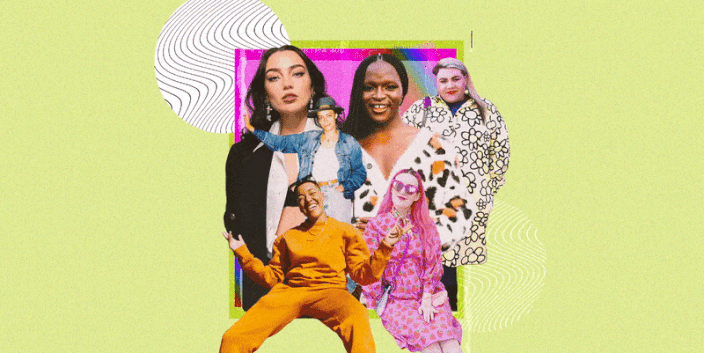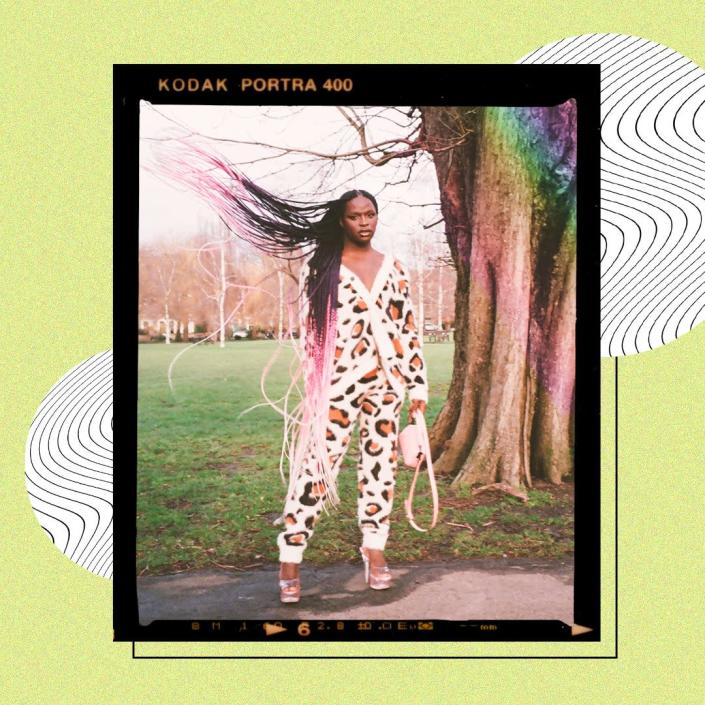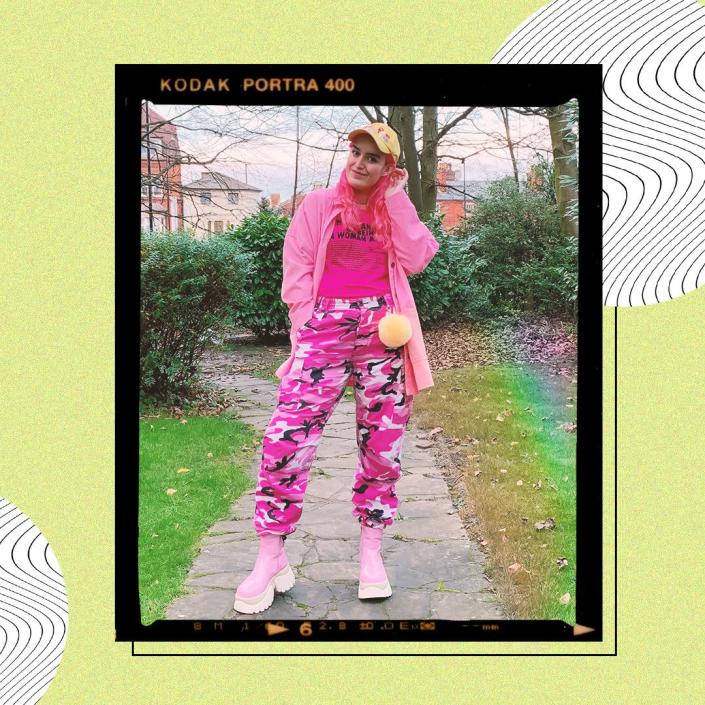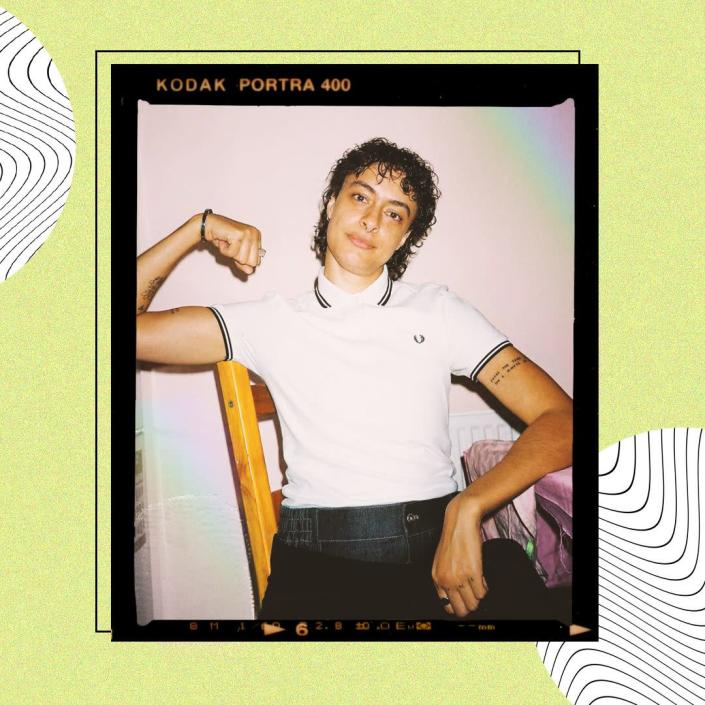Finding pride in our style

Our style – that is, the way we dress and groom ourselves – can present a powerful message to the world before we even speak. And nowhere is this more evident than in the queer community, where style can be used to express (or in some cases, repress) the unfolding of one’s authentic identity. This Pride Month, Cosmopolitan hears from six people in the UK’s LGBTQIA+ community about how style and creative expression have intertwined with their sense of self over the years.
As a fashion writer and stylist, I’m constantly inspired by people’s personal style. I’m fascinated by the way clothes can speak for us, especially when we really need them to. The six stories I heard below are full of bravery, confidence, and optimism – all qualities I hope the world will continue to champion not just during Pride Month, but all year long. – M.A.
Simone Murphy

Simone, a Scottish DJ and model who rose to fame on Britain’s Next Top Model, came out as bisexual to her social media followers during the pandemic. She describes her style as a mix of charity shop finds and classic staples, influenced by subcultures around the world from her travels. Find Simone on Instagram: @sim0ne
Says Simone, “After I came out, I felt like I could be a lot more queer-presenting. So I did that thing where I went out and got the gayest haircut you could possibly have. I got the mullet.” She laughs. “I feel like the beauty of being queer in your 20s is that you almost feel like a teenager again, because you’re getting to fully explore that part of yourself that maybe you weren’t so comfortable with before.”
The beauty of presenting in a less traditionally “straight” way, Simone explains, is that “then you don’t have to go through the process of repeatedly coming out once you’ve done it the first time – the big monumental one.” She continues, “I travel a lot with work – I was in Berlin and LA recently, and I feel like sexuality is just more of a fluid thing there; like you don’t have to address it. I feel like in the UK, it’s still [the case that] we very much label ourselves.”
Our talk turns to the queer style identifiers perpetuated by TikTok in recent years, and the popular ones she remembers. “Definitely Dr. Martens, but for a while, it was cuffed jeans, wasn’t it – that was a big one. There’s also ‘the ugliest sweater you’ve ever seen in your entire life’. Silver hardware jewellery too, and maybe…blazers I think are quite gay – like an oversized blazer? And anything with a platform.” Of course, most of these items on their own are seemingly insignificant; plain enough to have a space in almost anyone’s wardrobe – straight or otherwise. But on an app full of (mostly) younger people trying to find themselves, and sort life into neat, understandable categories, even something as innocent as the cuff of a jean can take on a hidden meaning, depending who you ask – or what your algorithm has learned to show you.
Simone ponders: “If sexuality exists on a sliding scale, it’s illogical to assume that we’d all start on one end of that scale. We’re just conditioned to be straight.” She notes that for some queer women especially, clothing can act as a protective armour. “If I’m in big platforms and my big jacket, I don’t find that as many men bother me inappropriately. But then when I go to a gay bar in London, I’m like, ‘oh, let me do bimbo-core for the night,’ and I’ll dress in an ultra feminine way knowing that I’m not being hyper-sexualised in that space.”
Darkwah

Artist and creator Darkwah Kyei-Darkwah believes that self-expression helps us connect with each other more easily. Find Darkwah on Instagram: @hausofdarkwah
Darkwah’s Instagram is full of bold, unapologetic outfits, but they explain that this wasn’t always the case when they were younger. Darkwah says, “I grew up queer in a traditional Ghanaian family and learned to experiment with clothing in very subtle ways at first. I identify as non-binary, with they/them pronouns, and so I just flow very freely between the binaries. My parents were both into fashion, so I could get away with wearing pink, lavender, and mint green, even though they were on more masculine garments. It felt like a way I could express myself, when not necessarily everyone around me understood my queerness yet.”
Darkwah reflects on a former, more masculine look: a shaved head, a beard, and “trousers with a really nicely polished shoe.” They explain, “I realised when I started growing my hair that there was a whole other side of my energy that I had repressed, like this…femme side. I’ve grown my nails long, and now I feel like my arms are complete. Because when you move, you see all of the ‘flourish’, you know? The longer the hair, the more articulate the movement – you feel like you’re moving through water. That’s kind of how I want to feel all the time. I want to feel like I’m floating.”
As a teenager, Darkwah worked at a luxury department store with a stuffy dress code of “boring, average” black suits, but small acts of defiance, such as “a pink tie and pink silk socks” made them feel more like themselves in the uniform. Why, then, is it so important for some of us to feel like we are being our authentic selves, even in restrictive environments? Darkwah tells me, “Self-expression is your truth. And when you tell your truth consistently to yourself, it’s easier to tell truth to others, and therefore easier to connect, because you don’t have to build up or tear down any walls. If I don’t feel comfortable, I’m not going to do whatever it is that I’m supposed to do well. So if I’ve ever “conformed,” I’ve always done it in a way that still feels very me.”
Darkwah describes the feeling of wearing an outfit that feels 110% true to them, saying, “I can just take this into the world and exist beautifully and powerfully within myself, and just feel secure. I’m constantly dressing for myself.” When asked how they deal with the occasional internet troll, Darkwah replies, “Sometimes people cling to structures, and then realise they’re losing, because those structures were prisons for people to repress themselves in. They’re scared to embrace themselves and maybe live outside of the four walls that have been created for them. They’re angry and lashing out – that has nothing to do with me. That’s a them problem.”
Tanya Compas

Tanya Compas is a youth worker, content creator, and founder of youth organisation Exist Loudly. She describes her style as ‘a mix between a lad and a hun,’ and has been embracing a more masculine approach to dressing lately. Find Tanya on Instagram: @tanyacompas
Tanya takes me back to her roots, saying, “I’ve always been a tomboy. My mum used to buy me boxers when I was a kid, and until I was 11 years old, I only wore boys’ clothing. But as my teen years arrived, I began to feel ashamed of dressing that way. I started to feminise myself. I started to wear make-up, because I thought, ‘that’s what women do’. My masculine side soon became reserved only for sport, and outside of that, I felt as though I had to be feminine.”
“I used to watch what everyone else was wearing, rather than ask, ‘what do I feel comfortable in?’ Back then, a lot of my validation was through the approval of men. And then, when I came out as gay, I started dressing even more feminine, because I didn’t want to make it obvious I was gay. Looking back, I felt shame and I wanted to hold on to the privilege that came with still being [perceived] as straight by strangers.”
Tanya continues, “It’s only in the past three years that I’ve gradually become more confident in expressing my masculinity. Now, my default is men’s clothing, but I’ll still wear a crop top or make-up if I feel like it – and not because I feel pressured to.” Tanya likes to ask people: “If you had access to all the clothing in the world, and you knew nobody could see you, but you’re wearing an outfit that makes you feel confident, what would that be? What’s holding you back from dressing that way now?”
Eleanor Medhurst

Eleanor Medhurst runs a lesbian fashion history blog called Dressing Dykes. Her outfits always involve pink – she even wrote her undergraduate thesis on the colour. Find Eleanor on Instagram: @elliemedhurst
Take a quick glance at Eleanor’s personal Instagram page, and you’ll immediately notice: the colour pink plays a starring role in her life. Eleanor shares, “[My thesis] was called Subverting Pink: Queer Reclamations of Hyper Feminine Dress. Pink is tied up with ideas of gender roles and heterosexuality, and in capitalism as well, with things like children’s toys and women’s products. That was a push from marketing forces to try and sell more things, because they could sell a different product to a woman than to a man.”
“To be a lesbian or queer woman, and to be taking on this colour, especially in such an exaggerated way… it sort of parodies those ideas, those gender roles. In the queer community, if pink is associated with anyone, it’s normally with gay men. So I think that it’s really powerful to wear it as a lesbian instead.”
Eleanor runs a detailed lesbian fashion history blog called Dressing Dykes, where she often investigates the origins of queer trends, like dungarees or mullet haircuts. She shares, “I always say that clothing is a way for us to speak when we’re not able to use our words or our voices. That’s particularly true in historical contexts where you couldn’t always be safely out as gay, but in modern ones too.”
She describes the enduring use in gay circles of “subtle fashion codes” that might act as a “little wink to people in the know,” but perhaps fly under the radar of more heteronormative communities, thus keeping the wearer safe. For example, Eleanor explains that gay women in the 1920s often wore subtle violet pins on their lapels, as a nod to the [6th-century, presumed queer] poetess Sappho. Eleanor feels it’s important to note, though, that queer fashion isn’t always focussed on sending coded signals to others. “Sometimes it’s just about dressing for your authentic self, rather than trying to be read in any particular way by other people,” she explains.
Ben Pechey

Ben Pechey, a writer, consultant and digital creator, describes their style as a ‘1990s British children’s TV presenter on acid’. Their latest project, The Book Of Non-Binary Joy, aims to give younger generations the language to express themselves. Find Ben on Instagram: @benpechey
Ben’s Instagram is a haven of joyful, confident outfits and messages of positivity. But Ben explained that it took a while to reach that place of confidence: “Growing up as a queer person in a small village, I was bullied from age 10 to 16, every single day. You see other people out in the world [like celebrities] wearing stuff you’d die for, but you just can’t yet. Then I went to a fashion uni and there was a large pocket of queer kids. I finally felt free, and so my exploration of self-expression began. You’re finally in control of your life, and suddenly, the way you dress says everything about your gender, sexuality and stance on the world. And it’s exciting. You can take 50% of who a person is from how they dress when they do it in a way that expresses their queerness.”
“My style now is essentially very colourful, lots of layers, lots of pattern clashes. It’s an explosion of just…joy for dressing. There’s no limit. There’s nothing I say no to. One day, I’ll be wearing an amazing pant suit. The day after I’ll be wearing like this huge frilly dress concoction thing. For me, dressing’s just about pleasure, and the joy it brings to me. I think from an outside perspective, that would probably be classed as very feminine, but for me, my body exists outside of gender. It’s just fun, sort of like code switching my identity through the silly bits of fabric I put on my body.”
Recalling the painful bullying at school, Ben remembers feeling “terrified just for existing.” Enduring that became the catalyst for Ben’s work today: “It’s why I poured my heart and soul into my book, The Non-Binary Book of Joy, to make sure that kids are more prepared, that kids have the right language. Their peers, and the grownups that help them, should understand that it’s not okay for kids to suffer in that way anymore.”
Celebrating our differences is part of Ben’s central message. “Difference is actually a really good part of society. And it’s what makes all of us more successful. It makes businesses thrive. It makes being human a little bit easier. Even if you don’t understand it, just allow people to be who they are.”
Laura Kirwan-Ashman

Laura Kirwan-Ashman, a writer and film director in London, describes their style as being ‘on the masculine end of the spectrum’. Laura is inspired by 1970s Bruce Springsteen, Americana workwear and the K-pop band BTS. Find Laura on Instagram: @laurak_a
Laura tells me, “I definitely dressed in a more feminine way when I was younger, but that gradually changed throughout my late twenties. I was single for the first time, and becoming part of this DIY and film collective scene in London. There were a lot of Black women, people of colour and queer people who were doing really cool and interesting things. The shift in my social circles organically led to a gradual examination of my identity.”
“Now, there’s not a single skirt or dress in my wardrobe, and I can’t imagine ever wearing those things again. I look at my clothes, and I’m like, who do I want to be today?” Laura describes some days having a “70s daddy vibe,” with retro shirts, flares, and loafers. “Seventies Bruce Springsteen is the pinnacle for me.” Other days, it’s an Americana workwear look, with vintage denim and tough work boots.
Laura continues, “For me, self-expression can partly be about signalling to other people – a way of saying “I’m queer” or “I’m into this kind of thing”. You can scan a crowd and notice someone with a certain haircut, or a certain pair of shoes, and think that that might be a “safe” or interesting person to befriend. I think it’s a really useful and human thing that we do – it’s like finding your tribe.’
—
If you or a loved one in the LGBTQ+ community need help or advice, visit stonewall.org.uk, or call 0800 050 2020.
—
Find Maddy on Instagram.
You Might Also Like






